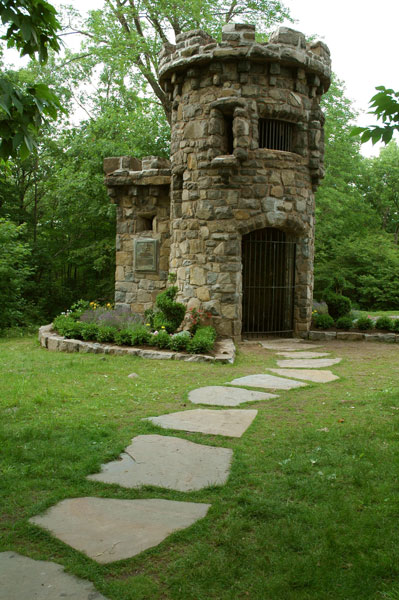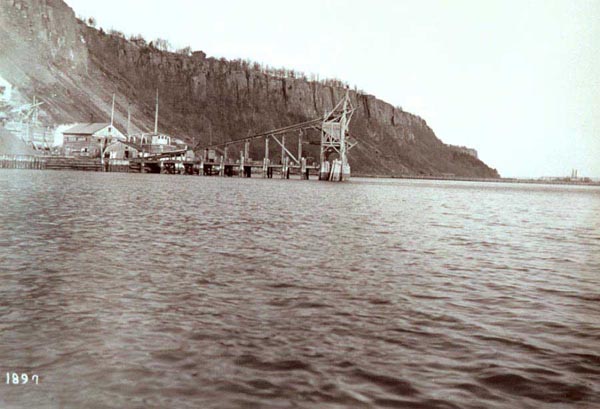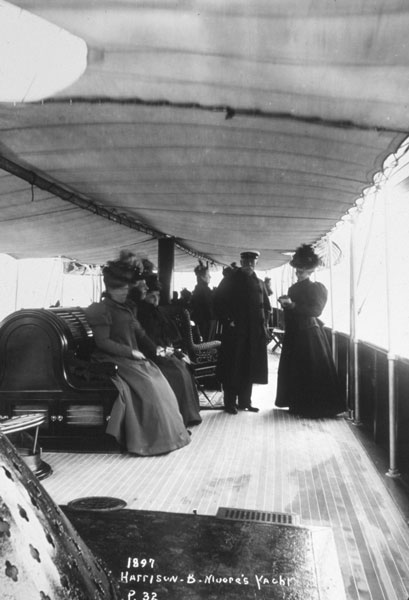A Stop along the Long Path
A “Cliff Notes” Story
September 2010
Kids love it: A castle, scaled to kid size and set in the middle of nowhere, off in the woods. We led a family hike past it in mid-August. From State Line Lookout we took the group south along the Long Path, then down the Forest View ravine and over the new bridge. As we started up the other side of the ravine, we let the kids go ahead, so they would get to the castle first.

“What is this place?” It was the grownups who asked; the kids had already scrambled up the little flight of stairs to the miniature battlement, whooping — “Whoa!” “Check it out!” — out over the Hudson, a mile wide and more than fifty stories below.
We told them how the “castle” was a monument built in 1929 to honor the role the New Jersey State Federation of Women’s Clubs played in preserving the Palisades. Its design was meant to evoke the ancient watchtowers along the River Rhine in Europe: poets had called the Hudson “the Rhine of the New World” or “America’s Rhine” because of its scenic beauty. Its beauty was so revered that a group of prominent American landscape artists in the nineteenth century went by the name “Hudson River School,” even though their paintings were sometimes of scenes far beyond the Hudson Valley.
By the 1890s, several big quarries had begun blasting the Hudson’s famous Palisades Cliffs for broken stone for railroad beds and for concrete. Many people who lived across the river in New York or who traveled on the river by steamship, or along its banks by train, felt outrage at the destruction these quarries were causing. Newspapers labeled the quarrymen “vandals.” A group calling itself the American Scenic and Historic Preservation Society studied the problem, to see if they could find a way to stop the quarries; some lawmakers suggested turning the Palisades into a military reservation, just to preserve them from the quarries — but the army wasn’t interested.
The blasting went on.

In Englewood, members of the Englewood Women’s Club decided that they would champion the cause of the Palisades. These women, mostly wealthy, knew the Palisades well; their families picnicked and hiked around the tall cliffs. Women’s Clubs had been formed all across the country to advance the role that women played in society; the Englewood women worked to get the New Jersey State Federation of Women’s Clubs, with sister clubs all across the state, interested in the Palisades cause. In 1897, the Englewood women convinced the Federation to hold its annual convention in the northern part of the state. During that convention, some of the leaders of the Federation ventured out in a yacht to view the quarry devastation first-hand. Their minds were made up: the Palisades must be saved.

The Palisades quarries were big business. They employed hundreds of men. At Carpenter Brothers’ Quarry in Fort Lee alone, over three hundred men worked, year-round. They shipped the stone as far as New Orleans, for a dollar a ton. For the men who owned the quarries, the fact that the prehistoric stone columns of the Palisades could be blasted down and broken and loaded onto barges — with no need for costly overland transportation — spelled big profits. No way would they close down their operations without a political fight.
It was the women of New Jersey, a generation before suffrage, who gave them that fight.
In 1900, Governor Foster Voorhees of New Jersey joined with Governor Theodore Roosevelt of New York to sign legislation passed in each state to form an Interstate Commission empowered to acquire and manage the Palisades lands. Money and support from powerful figures, including J. P. Morgan, enabled the Commission to buy out the quarries.
And so a unique Interstate Park had been created. Early on, the Commission acquired a piece of land on top of the cliffs at Alpine that they named “Federation Park,” where they planned to place a monument for the Women’s Clubs, with soaring views across the famous Hudson so far below…
And it was time to move on, to continue our hike. (It so happened that the very next day was the ninetieth anniversary of the passage of the Nineteenth Amendment to the United States Constitution: The right of citizens of the United States to vote shall not be denied or abridged by the United States or by any State on account of sex. The little “castle” on the Palisades, now part of New Jersey’s Women’s Heritage Trail, marks one stop along the long journey that led to that day in 1920 — when the right to vote was extended to more Americans than on any other day in our nation’s history.)

– Eric Nelsen –
Come on a virtual tour of the Women’s Monument! This video was made possible through support from NJ Women Vote: The 19th Amendment at 100, the NJ Historical Commission, the NJ Historic Trust, and the Alice Paul Institute.

